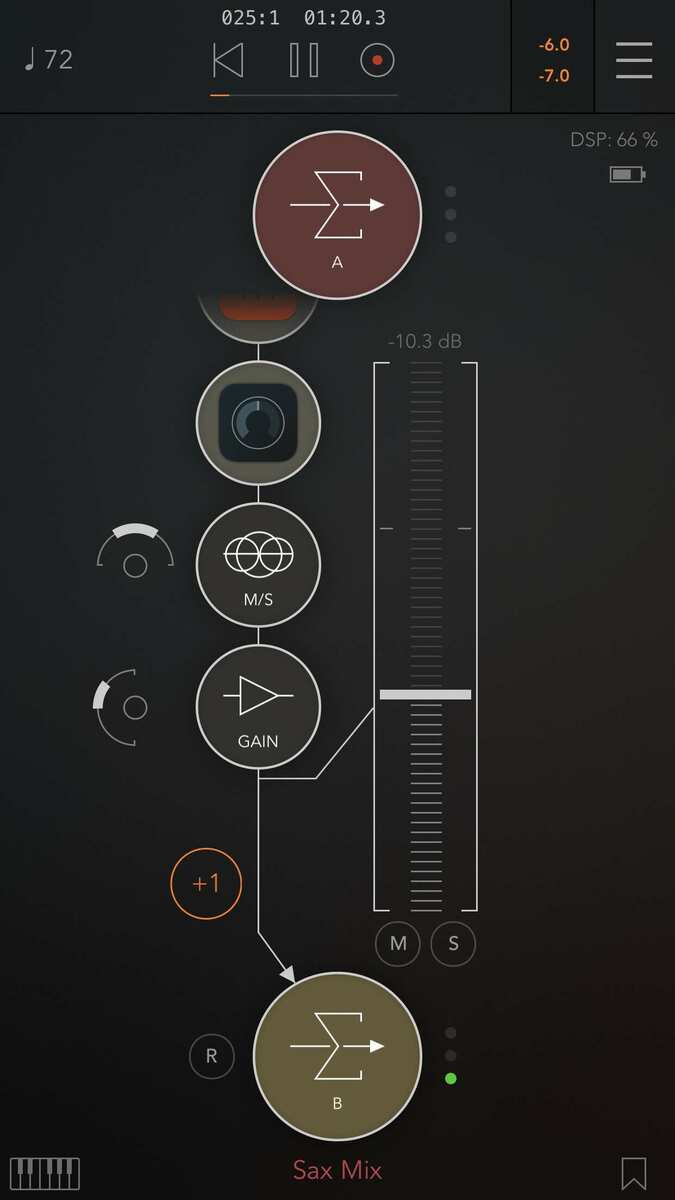Audiobus: Use your music apps together.
What is Audiobus? — Audiobus is an award-winning music app for iPhone and iPad which lets you use your other music apps together. Chain effects on your favourite synth, run the output of apps or Audio Units into an app like GarageBand or Loopy, or select a different audio interface output for each app. Route MIDI between apps — drive a synth from a MIDI sequencer, or add an arpeggiator to your MIDI keyboard — or sync with your external MIDI gear. And control your entire setup from a MIDI controller.
Download on the App StoreAudiobus is the app that makes the rest of your setup better.
Adding digital distortion in AUM can add nice sound color?
Today, I tried something on a mix in AUM.
On the tenor saxophone track of a whole mix, I’ve added an AUM gain node to boost signal while keeping fader to zero. When pushing settings, I was surprised that sound gets better with + 10 dB on gain node and around -8 dB on fader. When looking sax channel output meter and fader set to zero, I realized it was going red with + 2 dB. This makes sense as gain node is set as pre-fader effect. With fader set lower, meter was « redmeterless » again. I think AUM use 32 bits mixing, and really I was surprised by a sax which was sitting in the mix better, with added warmth and very gentle saturation on its whole frequency range.
Is it something known/used? I usually use plugs which reproduce tape saturation, but this gain/fader process involves digital saturation and sounds good.
I’ve read this article which was interesting too.
https://modernmixing.com/blog/2014/06/07/why-you-shouldnt-care-digital-clipping/




Comments
Interesting. I’m going to have to try this out. Thanks for the tip. I especially love tips that come from a accidental discoveries or unexpected results.
Yes it’s really accidental. I must add that gain node is added at the end of an effect chain which contain DDMF 6144 and NYcomp, and Eos2. So perhaps this digital saturation emphasizes or/and cut something in this wet signal, could be less interesting on a raw recording.
Yeah you are using top shelf plugins for sure. I will take that into consideration.
I’ve added a screenshot at first post for illustration : )
I’ve tried « saturation » node and it’s sounds as good « gain » node boost but without any red clipping. Better to go that way certainly.
In the screenshot you have a gain node at the end of the chain, just before the fader. You add some gain with the gain node, and remove some gain with the fader. Sorry to poop at the party, but any audible coloration from this must be a placebo, or simply that you might add more gain than you're removing and we do tend to think 2 dB increase in level makes it sound better.
If the gain node is before any non-linear or clippable fx node in the chain, then it would certainly affect the actual sound and not only the level. But at the position shown in the screenshot, it acts just exactly like a second fader.
I will give you a comparison recording ASAP : )